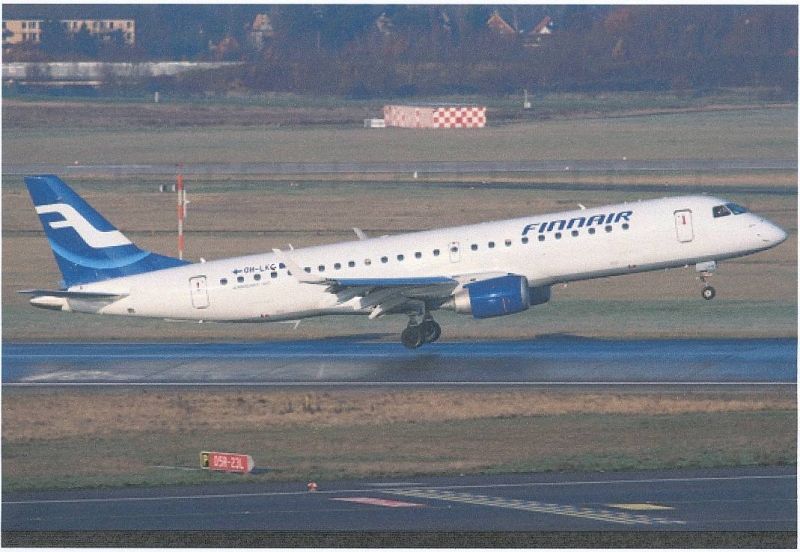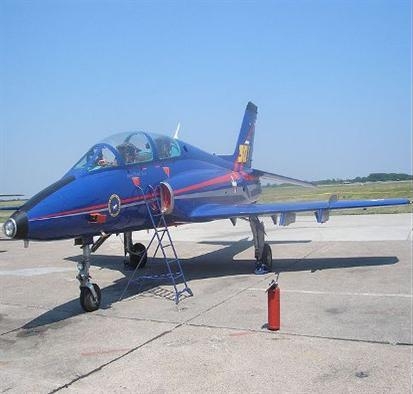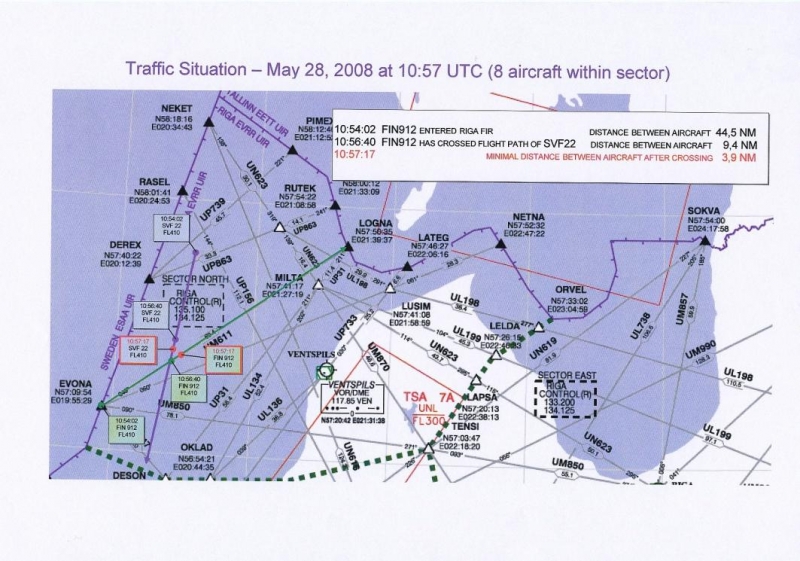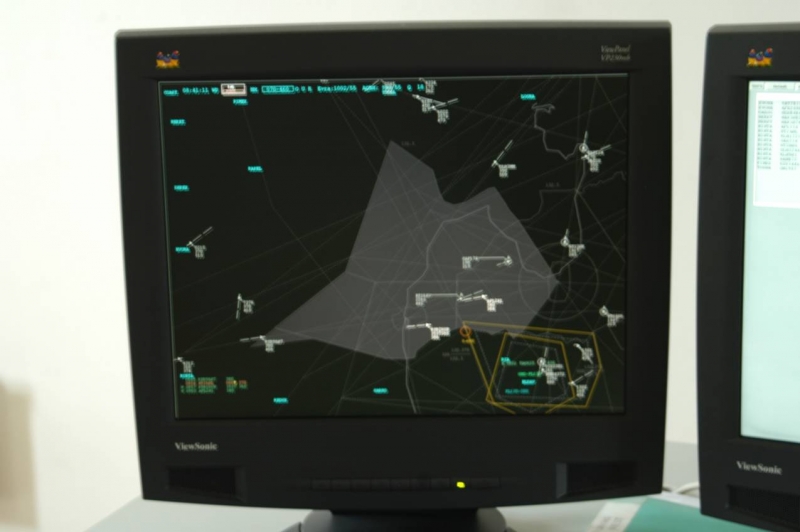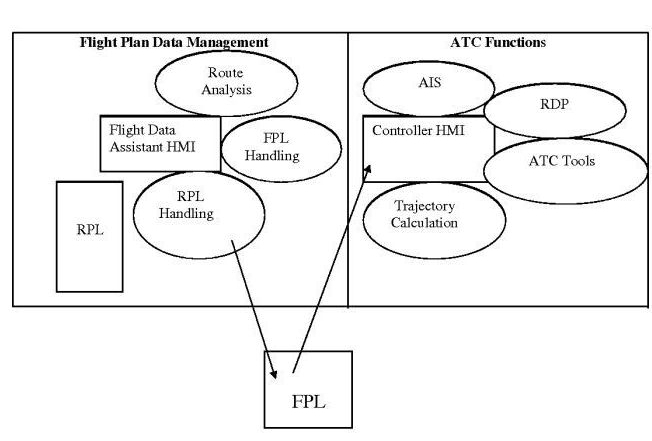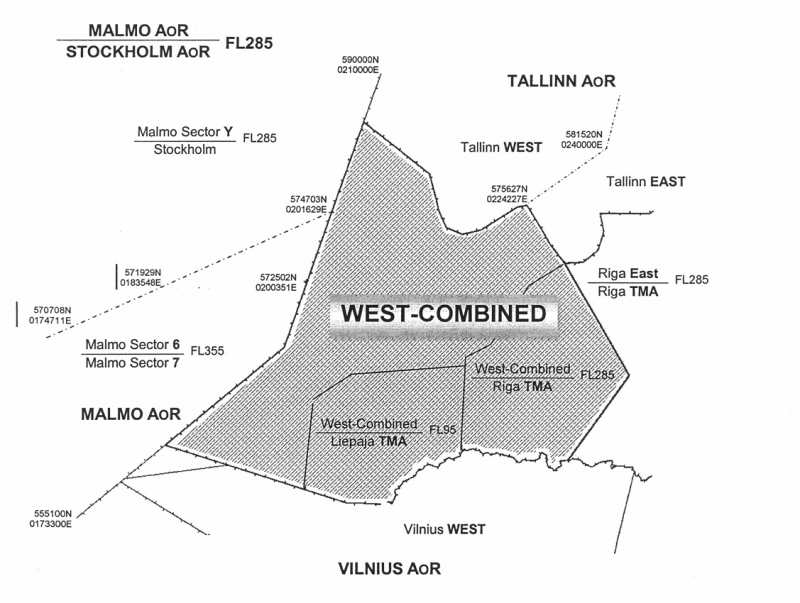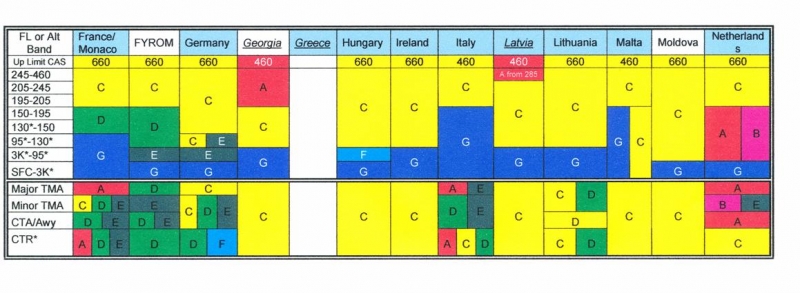Final Reprot Nr.5/2008 Of the Aircraft Serious Incident
Infringement of separation standards between the Finnair aircraft Embraer 190 OH-LKG, flight FIN912 and military Swedforce aircraft G4, call sign SVF 22 over the Baltic Sea near reporting point on request Evona (n57:09:54; e019:55:29) in the vicinity of Liepāja, on 28 May 2008
The Transport Accident and Incident Investigation Bureau of the Republic of Latvia is a governmental, independent of all aviation authorities’ organization, established by law to investigate and determine the cause or probable cause of accidents and serious incidents that occurred in the civil aviation, as well, if necessary for enhancing flight safety, incidents.
The sole purpose of such investigation is in accordance with Annex 13 of the Convention of Chicago, as well as the Directive 94/56/EC of 21 November 1994, establishing the fundamental principles governing the investigation of civil aviation accidents and incidents of the Council of the European Union, to prevent accidents and incidents and, if the Bureau finds it appropriate, to issue safety recommendations. The purpose of an investigation conducted under the responsibility of the Transport Accident and Incident Investigation Bureau Republic of Latvia is not to apportion blame or liability.
Address:
58 Brivibas Str., Riga
LV-1011, Latvia
Phone: 67288140
Fax: 67283339
E-mail: taiib@taiib.gov.lv
Director of Transport Accident and Incident Investigation Bureau
Ivars Alfreds Gaveika
Table of Contents
Synopsis
General information
Investigation
1. Factual Information
1.1. History of the flight
1.2. Injuries to persons
1.3. Damage to aircraft
1.4. Other damage
1.5. Personnel Information
1.6. Aircraft information
1.6.1. General
1.6.2. TCAS description
1.7. Meteorological information
1.8. Aids to Navigation
1.9. Communications
1.10. Aerodrome information
1.11. Flight recorders
1.12. Wreckage and impact information
1.13. Medical and pathological information
1.14. Fire
1.15. Survival aspects
1.16. Tests and research
1.17. Organizational and management information
1.18. Additional information
1.19. Useful or effective investigation techniques
2. Analysis
3. Conclusions
4. Safety recommendations
Appendices:
1. Radio communication records
2. Air Traffic Controller Report
3. Copy of Air Traffic Controller Rating Certificate to Air Traffic Controller Licence
4. Copy of Air Traffic Controller Licence
5. Copy of Medical Certificate Class 3 – holder Air Traffic Controller Instructor
6. Description of the radar picture (Traffic Situation - May 28, 2008 at 10:57 UTC)
7. Air Safety Report (ASR) of FINNAIR
8. The FDR data description of Boeing 757-200 YL-BDC
9. Regulations and procedures on ground - to - air radiotelephony PR- GSV/AvDN-01/2 of Latvijas Gaisa Satiksme
10. Certificate for maintenance validity of Air Traffic Control System ATRACC+ No028/8
11. ESARR 2 Reporting and Assessment of Safety occurrences in ATM
12. Air Traffic Controller’s time-table of Latvian ATC (GSVC)
Abbreviations
ATCC - Air Traffic Control Centre
ACC - Area Control Center
ATRACC - ATC System for Riga Area Control Centre
A-SMGCS - Advanced-Surface Movement Guidance and Control System
ACFT - Aircraft
TCAS - Traffic Alert and Collision Avoidance System
SSR - Secondary Surveillance Radar
PSR - Primary Surveillance Radar
ARCC - Aeronautical Rescue Co-ordination Centre
ATC - Air Traffic Control
UTC - Universal Time Coordinated
UTA - Upper (Traffic) Control Area
CTA - Control Area
TMA - Terminal Control Area (ICAO)
TIA - Traffic Information Area
TIZ - Traffic Information Zone
AoR - Areas of Responsibility
CWP - Controller Working Position
ReportRVSM - Reduced Vertical Separation Minimum
ODS - Operator input and Display System
VOR - VHF Omni Directional Range
ILS - Instrument Landing System
DME - Distance Measuring Equipment
RA - Resolution Advisory
NM - Nautical mile
FT - Feet
MSL - Mean Sea Level
Z - Zulu = Universal Coordinated Time (UTC)
ESARR5 - EUROCONTROL Safety and Regulatory Requirement on ATM personel
FIR - Flight Information Region
UIR - Upper (flight) Information Region
FIS - Flight Information Services
FPL - Filed Flight Plan (ICAO format)
RPL - Repetitive Flight Plan
HMI - Human Machine Interface
EHSI - Electronic Horizontal Situational Indicator
OSUP - Operational Supervisor
FAP - Final Approach Point
METAR - Meteorological Aviation Routine Weather CAVOK - Ceiling and Visibility OK
VMC - Visual meteorological condition SAR - Search and Rescue
CISM - Critical Incident Stress Management
SSR - Secondary Surveillance Radar
ESARR - Eurocontrol Safety and Regulatory Requirement
PANS-ATM - Procedures for Air Navigation Services - Air Traffic Management
STCA - Short-Term Conflict Alert
CTR - Control Zone
FL - Flight Level
RBPS - Radar Bypass System
SARPs - Standards and Recommended Practices
Synopsis
Unless stated otherwise the time in this Report is UTC
On Wednesday, 28 May, 2008 at 10:57 UTC a serious aircraft incident took place in Riga FIR, near reporting point on request EVONA (N57:09:54; E019:55:29), in the vicinity of Liepaja. A FINNAIR EMBRAER 190 (Picture 1), OH LKG, Finland, FLIGHT FIN912 was en route from airport Berlin-Tegel to Helsinki - Vantaa airport cruising at FL 410. At the same time SwedForce military aircraft G 4 (Picture 2), call sign SVF 22 had performed flights over Baltic Sea, outside air routes according of flight plan. At 10:50:36 FIN912 maintaining FL 410 had radar contact with the Riga ATC WEST-COMBINED sector controller (hereinafter ATCO1) and was assigned a transponder code - “Squawk 4302”. At 10:54:02 FIN912 entered in Riga FIR, distance between aircraft was 44,5NM. At 10:56:40 when FIN912 has crossed flight path of SVF 22 what was cruising at same FL410 from north distance between aircraft was 9,4NM. Only at 10:56:46 ATCO1 cleared FIN912 to descend at FL400 as well as gave instruction for SVF 22 to turn 90 degrees right immediately.
At 10:57:17 the two aircraft passed each other in the RIGA Flight Information Region and the separation standard between the two aircraft was infringemented. Minimal distance between aircraft was 3,9NM.
The conflicting traffic was in sight for aircrafts crews, so Boeing 752, FLIGHT BTI65T and AIRBUS A340-600, FLIGHT VIR301 passed each other by left side. Visual meteorological conditions existed at the time of incident.
Notification
The Transport Accident and Incident Investigation Bureau of the Republic of Latvia was notified about the incident on Wednesday, 28 May, 2008 by the duty officer of ARCC Riga, a structural part of LGS responsible for co-ordination of SAR operations within Riga FIR, Riga International Airport.
TAIIB Authorities had evaluated the received information relevant to that case and initiated formal investigation into this serious incident, under the provisions of Annex 13 to the Convention on International Civil Aviation (Chicago 1944) and the Republic of Latvia Cabinet Regulation No 660, Adopted 25 November 2003 as well as forwarded request to FINAIR of providing any relevant available information regarding the aircraft and personal data of flight crew involved in the serious incident.
1. Factual Information
1.1. Sequence of events
1.1.1. Flights involved in the incident
The incident took place on Wednesday, May 28, 2008, at 10:57:17 UTC over the sea near reporting point on request EVONA (N57:09:54; E019:55:29), in the vicinity of Liepaja. A FINNAIR EMBRAER 190 OH LKG, Finland, FLIGHT FIN912 was en route from airport Berlin-Tegel to Helsinki-Vantaa airport cruising at FL 410. At the same time SwedForce military aircraft G 4 (Picture 2), call sign SVF 22 had performed flights over Baltic Sea, outside air routes according of flight plan. On recept information from Malmo ATCC about scheduled flying into Riga FIR EMBRAER 190, FLIGHT FIN912 ATCO1 resolved to decrease flight level of FIN912 to FL 400 after passing it reporting point on request EVONA. At 10:50:36 the crew of FIN912, cruising at FL 410 using controller pilot data link communications (CPDLC) established contact with Riga ATC WEST-COMBINED sector controller ATCO1 and was assigned a transponder code – “Squawk 4302”. At 10:54:02 FIN912 entered in Riga FIR, distance between aircraft was 44,5NM. (see Picture 3) At 10:56:40 when FIN912 has crossed flight path of SVF 22, what was cruising at same FL410 from north, distance between aircraft was 9,4NM. The ATCO1 coordinated the other traffic within center (there are 8 aircraft actually) as well as had got information from adjacent sector controller. FIN912 was cleared to descend at FL400 with delay at 10:56:46 by ATCO1. (See Picture 4), as well as gave instruction for SVF 22 to turn 90 degrees right immediately.
FIN912 has crossed flight path of SVF 22
|
10.50.36 |
P (pilot) |
Riga Control, FIN 912 maintaining level 410 |
|
|
C (contr) |
FIN 912 Riga Control radar contact |
|
10.53.17 |
C |
FIN 912 squawk 4302 |
|
|
P |
Squawk 4302 FIN 912 |
|
10.56.46 |
C |
FIN 912 sorry, immediately descend FL 400 |
|
|
P |
Descending 400, FIN 912 |
|
|
C |
SwedForce 22 sorry, turn right 90 degrees immediately |
|
|
P |
Turning right 05... confirm 50 degrees? |
|
|
C |
Affirm |
|
|
P |
We are visually.... We.. (unreadable) |
|
10.58.12 |
P |
Riga SwedForce 22 can we continue course now? |
|
|
C |
SwedForce 22 resume own navigation |
|
|
P |
Own navigation gals |
|
10.59.29 |
P |
Riga FIN 912 |
|
|
C |
912 go ahead |
|
|
P |
Could you confirm lost of separation at FL 410 with trafficatFL410? |
|
|
C |
912 it was military aircraft G 4 |
|
|
P |
Call sign G 4, confirm? |
|
|
C |
Negative, SwedForce 22 and type of aircraft G 4 |
|
|
P |
Roger, SwedForce 228, FIN912 |
|
|
C |
Negative, call sign S V F 22 |
|
|
P |
SVF22, FIN912, roger |
|
|
P |
Riga, say again for SwedForce 22 |
|
|
C |
SwedForce 22 disregard |
|
11.02.55 |
C |
FIN 912 contact Tallinn Control 132,5 |
|
|
P |
132,5 Tallinn, FIN 912 |
|
|
C |
Good-bye |
Ground –to-air radiotelephony record, Picture 4
The conflicting traffic was in sight for aircraft crews, so at 10:57:17 EMBRAER 190, FLIGHT FIN912 and military aircraft G 4, call sign SVF 22 passed each other by left side, but the separation standard between the two aircraft was infringemented. Minimal distance between aircraft was 3,9NM. Visual meteorological conditions existed at the time of incident.
1.1.2. Events in the Riga air traffic control center
In the Morning of Wednesday, May 28, 2008, one of air traffic controller (ATCO1) was on duty for ATS provision in the WEST-COMBINED sector of Riga FIR at the moment when the incident occurred. Sector WEST-COMBINED provides services within sector SOUTH AoR and sector NORTH AoR. Working position of the Sector WEST-COMBINED is shareable between a controller with operational role “WEST-EXECUTIVE” and a controller with operational role “WEST-PLANNER” appointed by the Operational Supervisor during the highest flight intensity hours ATS is provided at flight levels from FL100 till FL460.
According to the time-table for May, 2008 of Latvian ATCC (GSVC), ATCO1 working shift D2 on May 28, 2008 began at 07:06 (UTC). From 10:15 till 11:16, respectively at the moment when the incident occurred ATCO1 had occupied a position in sector with operational role “WEST-EXECUTIVE”. Total working - time up to incident (at 10:57) is 02 hr 27 min.
1.2. Injuries to persons
There were no injuries.
1.3. Damage to aircraft
Not damage occurred.
1.4. Other damage
Objects other than aircraft not damaged.
1.5. Personnel information
Air traffic controller: Male, 42 years, Licence: Air traffic controller, valid until June 10, 2009.
Medical certificate: Air traffic controller Medical Certificate Class 3, valid until October 24, 2009.Ratings: All necessary ratings were valid (Rating Certificate to Air Traffic Controller Licence valid until June 10, 2009).
Captain of EMBRAER 190: 37 years old;
Ratings: All necessary ratings were valid;
Total flight experience - 2482 hours (in FINNAIR);
Total hours last 90 days - 189h 44min (in FINNAIR);
Flight time last 24 hours - 1h 54min;
Flight experience on aircraft EMBRAER 190 - 127h 24min.
First officer of EMBRAER 190: 39 years old;
Ratings: All necessary ratings were valid;
Total flight experience - 212h 24min;
Total hours last 90 days - 187h 13min;
Flight time last 24 hours - 1h 54min;
Flight experience on aircraft EMBRAER 190 - 212h 24min.
Pilot of G4 SVF22 - Data NA.
1.6. Aircraft information
Aircraft type – EMBRAER 190;
Registration – OH-LKG;
Owner of aircraft – airline FINNAIR;
Aircraft type – military G 4;
Owner of aircraft – SwedForce.
1.7. Meteorological information
Weather conditions on May 28, 2008 (10:30 -11:30 UTC) in the West-Combined Sector of Riga ATCC.
|
Air pressure |
Altitude to MSL |
Wind direction |
Wind speed |
Air temperature |
Dew-point temperature |
|
200hPa |
39000FT |
315° |
42kt |
-62,4° |
-71,4° |
|
150hPa |
45000FT |
320° |
25kt |
-58,4° |
-85,4° |
1.8. Aids to Navigation
The flights were under Radar control. Air Traffic Control System ATRACC+ (Manufacturer, s serial No N SI P 101.1) is an ATM system for area, approach and tower Control of the Riga FIR. From a functional point of view, the system consists of two main components: a Primary System, and a Radar Bypass System. A Primary System providing multi radar tracking advanced flight plan data integration, predicted flight trajectories, OLDI (On-Line Data Interchange), silent co-ordination and paperless HMI. A Radar Bypass System for use if the primary system should fail. The Radar Operator Workstation is common for the Primary System, and the Radar Bypass System.
Four main functional blocks are defined:
- The Flight Plan Data Management block
- The ATC Functions
- The Support Functional block and the ATC-Simulator
The distinct border is between the Flight Plan Data Management block and the ATC Functional block. A Flight Data Assistant, (FDA) is working with Repetitive Flight Plans, (RPLs) and passive Flight Plans, (FPLs) in the Flight Plan Data Management block while the ATC controller is working with active FPLs in the ATC Functional block. Flight plan data management is available at flight data assistant working positions. The Flight Data Assistant HMI has efficient support for editing, browsing, queue handling and specification of complex search criteria.
RPLs can be searched, created, modified and deleted manually, but also automatically based on airline time schedules on data media. FPLs are normally created automatically from RPLs or received from AFTN. They can also be searched, created, modified and deleted manually. Received AFTN and OLDI messages are processed and checked automatically and produce updates of concerned FPLs. Billing data is automatically submitted to external systems at FPL termination. For RPLs and FPLs both, route analysis is done and route details are examined against the local airspace structure for compliance with ICAO rules.
The airspace structure is defined by means of system parameters. ATC functions are available at controller working positions. Controller interaction with flights is performed through extensive use of lists and flight symbols. A trajectory describing the flight path in airspace is calculated with consideration to aircraft performance characteristics and current weather data. The trajectory’s coverage of ATC sectors determines the distribution of flight data to working positions. Data from PSR and SSR radar stations is processed by means of an advanced centralized true multi-radar tracker. The resulting system tracks are associated with FPLs. Flight symbols comprising surveillance and flight plan information are presented to controllers.
1.9. Communications
The radio communication between the aircraft and ATCO was held on the frequency 135,1 MHz in English. For the investigation the ATCO console recordings on the frequency 135,1MHz was used. The quality of the recordings was good.
Read – Back clearances
The flight crew shall read back to the ATCO safety –related parts of ATC clearances and instructions which are transmitted by voice. The following items shall always be read back:
- ATC route clearance;
- Clearances and instructions to enter, land on, take off from, hold short of, cross, taxi and backtrack on any runway;
- Runway in use, altimeter settings, SSR codes, level instructions, heading and speed instructions and whether issued by the controller or contained in automatic terminal information service broadcasts, transition levels.
Other clearances or instructions, including conditional clearances, shall be read back or acknowledged in a manner to clearly indicate that they have been understood and will be complied with.
ATCO1 and crew members of FIN912 as well as G4 SVF 22 have used standard phraseology and there had not principal errors in the used phraseology.
Communication Transcript there was not inaccuracies in radio communications on all sides.
1.10. Aerodrome information
The airport did not have any significance for the incident.
1.11. Flight recorders
The incident reconstruction was based on the radar records and voice communications transcript between controller ATCO1 of Riga ATCC and aircrafts crew members as well as available FDM data.
Printout from fda2 29 May 2008 07:46
FDB532 2000
FF EVRRZDZX EVRRZQZX
272000 EBBDZMFP
(FPL-SVF22-IM
-GLF4/M-SDGHIPRUWXYZ/S
-ESCF0800
-M080F390 DCT SC DCT 5814N01854E DCT 5810N02000E DCT 5915N02115E DCT 5710N02025E DCT GARŠO UP733 TIGNU DCT KUNER DCT 5510N01800E DCT 55N017E DCT DEVEL DCT 5430N01440E DCT DEVEL DCT 55N017E DCT 5510N01800E DCT KUNER DCT TIGNU UP733 GARŠO DCT 5710N02025E DCT 5915N02115E DCT 5710N02025E DCT GARŠO UP733 TIGNU DCT KUNER DCT 5510N01800E DCT 55N017E DCT DEVEL DCT 5430N01440E DCT DEVEL DCT 55N017E DCT 5510N01800E DCT KUNER DCT TIGNU UP733 GARŠO DCT 5813N02050E DCT NEKET DCT SC DCT -ESCF0400 ESSP
-REG/102 002 OPR/SAF STS/STATE STS/ATFMEXEMPTAPPROVED COM/0013212050204 DOF/080528 ORGN/ESSAZPZX)
FDB630 2155
FF EVRRZDZX EVRRZQZX
272155 EBBDZMFP
(FPL-FIN912-IS
-E190/M-SDEGJPRWY/S
-EDDT0955
-N0441F3 90 RAKITIT RAKIT UZ717 BODLA UL132 DEMUR UN746 KOLJA UM611
LOGNA UM608 INTOR
-EFHK0128 EFTU
-EET/EDUU0009 EPWW0012 ESAA0027 EVRR0054 EETT0103 EFIN0127 REG/OHLKG
OPR/FIN COM/AGCS DAT/V RMK/TCAS DOF/080528 RVR/300 ORGN/EFHKFINO)
1.12. Wreckage and impact information
Not damage.
1.13. Medical and pathological information
Not relevant to this incident.
1.14. Fire
There was no fire.
1.15. Survival aspects
Not necessity to survey.
1.16. Tests and research
Were not performed.
1.17. Organizational and management information
According to Law on Aviation of the Republic of Latvia the authority responsible for activities of the utilisation of the airspace of the Republic of Latvia for civil and military needs and the flight of aircraft shall be controlled by the Air traffic control unit - the State Stock Company - Latvian Air Traffic (Latvijas Gaisa Satiksme - LGS) which is the air traffic service provider in the Republic of Latvia. Air traffic control has provided in the airspace of Riga FIR, by Latvian Air Navigation Services (LGS) staff. For the ATS provision the following areas of responsibility (AoR) are established within Riga FIR/UIR: Sector EAST, Sector SOUTH, Sector NORTH, Riga TMA, Riga CTR, Liepaja TMA, Liepaja CTR, Ventspils TIA and Ventspils TIZ. Sector WEST provides ATS within NORTH AoR, SOUTH AoR, Liepaja TMA AoR, and Ventspils TIA AoR.
According to WEST-COMBINED Sector controller technological procedures DI-GSV/GSVC-02 of Riga ATCC, working position of the sector WEST-COMBINED is shareable between a controller with operational role “WEST Executive” and a controller with operational role “WEST Planner” appointed by the Operational Supervisor (OSUP) during the highest intensity hours. When traffic intensity permits one Controller may provide the service at WEST Sector with operation role “WEST Executive”. According to “Sector capacity recalculation and the control of the air traffic demand” (Attachment A of Sector controller technological procedures DI-GSV/GSVC-02 of Riga ATCC) maximal allowed capacity per hour for WEST-COMBINED Sector when employed 1(one) controller is 31 and respectively the air traffic demand 30. If the capacity per hours is forecasted to be more than allowed for employing 1(one) controler and there is not possible to organize of 2 (two) controllers or if the capacity per hours is forecasted to be more than allowed for employing 2(two) controllers, OSUP during the shift shall to determine the capacity of the sector depending from the number of the controllers and shall to warn the adjacent control centres about capacity restrictions for the centres.
Within Riga CTA/UTA vertical separation is carried out according to ICAO Annex 2 Table of Cruising levels 3a and applied between FL 290 and FL 410 inclusive -1000ft (300m). Horizontal separation (radar separation) if double SSR coverage is provided between identified, controlled aircraft not less than 5NM. Sector WEST-COMBINED provides services within sector SOUTH AoR and sector NORTH AoR. ATS is provided at flight levels from FL 100 till FL 460. FIS is provided at and below FL 95 and above FL460. Sector WEST-COMBINED controller provides ATS using VHF radio station on frequency 135,1 MHz, re-transmitter Liepaja and Spare on frequency 135,1MHz, ATS systems ATRACC+, pilot’s reports.
According to technological procedures of Riga ATCC at the start of the shift controller has to login in the ATRACC+ system. The start of the shift is determined by the login time. All temporary substitutions shall be performed via login procedure. Substitution of the controller is determined by the operational or the administrative supervisor. A temporary leaving of the working position during the shift requires a substitution.
Within the framework of Quality Management System (QMS) Riga ATCC are worked out “Regulations and procedures on ground-to-air radiotelephony” PR-GSV/AvDN-01/ 2 which are applicable for the provision of Air Traffic Services within RIGA FIR/UIR. The provisions of this document are based on ICAO SARPs, ICAO Regional procedures. The provisions of this document are mandatory for ATS personal conducting direct ground-to-air radio communications.
1.18. Additional information
Not applicable.
1.19. Useful or effective investigation techniques
The incident has been investigated in accordance with Annex 13.
2. Analysis
2.1. General
The investigation of the serious incident – infringement of separation standards between FINNAIR EMBRAER 190, FLIGHT FIN 912 and SwedForce G4, YL-BDC, call sign SVF 22 was orientated essentially around the following questions:
- Had Air Traffic Control Services unit procedures, operations and instructions an influence on the incident?
- Had West-Combined Sector controller actions an influence on the incident?
- What kind of the human errors had influence on the incident?
The analysis concerned the activities of FINNAIR FIN912 and SwedForce SVF 22 crew radio communications transcript, radar recording and air operation service instructions.
2.2. Explanation of the situation
At 10:50:36 in the controlled airspace of Riga FIR/UIR WEST-COMBINED Sector has not been very high traffic activity, there were 8 aircraft under service. Controller (ATCO1) had worked at the time of incident with operational role “Executive” at the post of area of responsibility “SOUTH” WEST-COMBINED Sector. According to Sector Capacity recalculation and the control of the air traffic demand of technological procedures DI-GSV/GSVC-02 of Riga ATCC at the time of incident the traffic can handle just one controller. The incident occurred within the Riga ATCC in Class A controlled airspace (See Picture 9), were operating under IFR and were on radio contact with Riga ATCC WEST-COMBINED Sector on VHF frequency 135,1 MHz. The classifications adopted by ICAO are: Class A- All operations must be conducted under Instrument Flight Rules (IFR) or Special visual flight rules (SVFR) and are subject to ATC clearance. All flights are separated from each other by ATC.
Both aircrafts flew at transversally direction on the FL 410 and had radar contact at the time of incident.
2.3. Air Traffic Control Services procedures, operations and instructions, air traffic controller actions
The controller shall be provided with the capability to respond to messages, including emergencies, to issue clearances, instructions and advisories and to request and provide information, as appropriate.
The chain of events that led to this incident was following:
At 10:54:02 when FIN912 entered in Riga FIR, there were not unsafe situation when an avoidance action would have been appropriate, because distance between aircraft was 44,5NM. (see Picture 3). The controller did not clear the FIN 912 to descend to flight level FL400 duly. At 10:56:40 when FIN912 has crossed flight path of SVF 22, what was cruising at same FL410 from north transversally to flight path of FIN 912, distance between aircraft was 9,4NM. The ATCO1 coordinated the other traffic within center (there are 8 aircraft actually) as well as had got information from adjacent sector controller. FIN912 was cleared to descend at FL400 with delay only at 10:56:46 by ATCO1. (See Picture 4), as well as was issued instruction for SVF 22 – “SwedForce 22 sorry, turn right 90 degrees immediately.”
The conflicting traffic was in sight to each other aircraft crews, so at 10:57:17 EMBRAER 190, FLIGHT FIN912 and military aircraft G 4, call sign SVF 22 passed each other by left side, but the separation standard between the two aircraft was infringemented. Minimal distance between aircraft was 3,9NM.
Accordingly to air control unit Air Traffic Control Services procedures, operations and instructions the investigation had stated following:
- Procedures, operations and instructions of air control unit - the State Joint Stock Company Latvijas Gaisa Satiksme (LGS) have complied with the requirements of ICAO Doc 4444-RAC/501 “PROCEDURES FOR AIR NAVIGATION SERVICES, RULES OF THE AIR AND AIR TRAFFIC SERVICES” as well as has a quality management system which covers all air navigation services it provides;
- The scope of the Air Traffic Control Services procedures, operations and instructions had not essential influence to incident.
According to EUROCONTROL guidance material (ESARR 2 Guidance to ATM Safety Regulators, EAM 2/GUI 1, Severity Classification Scheme for Safety Occurrences in ATM, Edition 1.0, edition date 12-11-1999), see tables I,II, this incident is classified as Major Incident - B -Loss of separation (separation higher than half the separation minima/e.g., 4NM) which is not fully under ATC control.
Taking into account the Severity Classification Scheme that specifies five qualitative frequency categories this incident is classified as B3.
|
SEVERITY |
A |
Serious incident |
A1 |
A2 |
A3 |
A4 |
A5 |
|
B |
Major incident |
B1 |
B2 |
B3 |
B4 |
B5 |
|
|
C |
Significant incident |
C1 |
C2 |
C3 |
C4 |
C5 |
|
|
D |
Not determined |
D1 |
D2 |
D3 |
D4 |
D5 |
|
|
E |
No safety effect |
E1 |
E2 |
E3 |
E4 |
E5 |
|
1 |
2 |
3 |
4 |
5 |
|
Very Frequent |
Frequent |
Occasional |
Rare |
Extremely rare |
|
FREQUENCY |
||||
Table I. - Severity Classification Scheme for Aircraft Incidents
|
FREQUENCY |
DEFINITION |
|
Extremely rare |
Has never occurred yet throughout the total lifetime of the system. |
|
Rare |
Only very few similar incidents on record when considering a large traffic volume or no records on a small traffic volume. |
|
Occasional |
Several similar occurrences on record - Has occurred more than once at the same location. |
|
Frequent |
A significant number of similar occurrences already on record - Has occurred a significant number of times at the same location. |
|
Very Frequent |
A very high number of similar occurrences already on record- Has occurred a very high number of times at the same location. |
Table II. - Definitions of Accident/Incident Frequency
2.4. Underlying Human Factors problems associated with incident
For revealing causation of this incident it was put into practice the taxonomy of the Human Factors Analysis and Classification System that describes the human factors that contribute to an incident. It is based on a sequential or chain-of-events theory of accident causation. The human contribution don’t build on the person approach, that focuses on the errors and violations of individuals but is based on the system approach, that traces the causal factors back into the system as a whole. The investigation view is not that Human Error is a cause of incident but that Human Error is a symptom of trouble deeper inside a system. The classification system has four levels, each of which influences the next level. These four levels are called:
- organizational influences;
- unsafe supervision;
- preconditions for unsafe acts;
- unsafe acts of operators.
Human factors played the major role in the cause of this incident and this further reinforces the requirements to examine the role of human factors in the Air Traffic Control.
2.5. Unsafe acts of operators
The unsafe acts can be loosely classified into two categories: errors and violations.
I. Errors
During investigation here were fixed following errors that ultimately led to the serious incident.
1. Skill- Based error
Air traffic controller on duty failed to prioritize attention during communication with adjacent sector controller and attention failure of actual situation in the airspace.
2. Decision errors
Poor decision of air traffic controller to clear the FIN 912 to descend to flight level FL400 duly.
II. Violations
Investigation didn’t reveal any violations such as willful disregard for the rules and regulations that govern safe flight.
2.6. Preconditions for unsafe acts
Two major unsafe subdivisions of unsafe conditions are developed:
- substandard conditions of operators;
- substandard practices of operators.
I. Substandard conditions of operators
Investigation didn’t reveal any substandard conditions of operators such as adverse mental states, physiological states as well as physical/mental limitation.
II. Substandard practices of operators
Generally speaking, the substandard practices of operators can be summed up in two categories:
- resource mismanagement;
- personal readiness.
Within the context of this incident this includes coordination both within and between aircraft with air traffic control facilities. There not revealed poor coordination among aircrew and air traffic controller.
Personal readiness failures occur when individuals fail to prepare physically or mentally for duty. Within the context of this incident there not revealed personal readiness failures when operators fail to prepare physically or mentally for duty.
2.7. Unsafe supervision
Exist four categories of unsafe supervision:
- inadequate supervision;
- planned inappropriate operations;
- failure to correct a known problem;
- supervisory violations.
Within the context of this incident there was not reveled any inappropriate supervision of operations.
2.8. Organizational factors influencing incidents
Fallible decisions of upper-level management directly affect supervisory practices, as well as the conditions and actions of operators. The most elusive of latent failures revolve around following issues of organizational influences:
- Resource management;
- Organisational climate;
- Operational process.
Within the context of this incident there were not find lack of human resources, budget resources, deficient planning, as well as were not find any adversarial, or conflicting, or when they are supplanted by unofficial rules and values and confusion abounds that could to have influence on creation of this serious incident.
3. Conclusions
During process of investigation were made the following conclusions:
3.1. Findings
- Authentic information about occurrence was received from the duty officer of ARCC Riga, a structural part of LGS responsible for co-ordination of SAR operations within Riga FIR. According to given information occurrence can classify as serious incident;
- At the time of the incident the traffic was handled by an air traffic controller of West-Combined sector with operational role “WEST Executive”;
- The controller did not clear EMBRAER 190 flight FIN 912 to descend from FL410 to FL400 duly;
- The air traffic controller held valid licence and ratings;
- The incident occurred within the Riga FIR/UIR WEST-COMBINED SECTOR;
- At the time of incident in the controlled airspace of Riga FIR/UIR WEST-COMBINED Sector has not been very high traffic activity;
- Both aircrafts involved were flying in Class A controlled airspace;
- The aircrafts were flying on same flight level FL 410;
- Both aircrafts involved were operating on IFR flight plans;
- The flights were under Radar control;
- Air Traffic Control System ATRACC+ (Manufacturer, s serial No N SI P 101.1) is an ATM system for area, approach and tower Control of the Riga FIR;
- Within Riga CTA/UTA vertical separation is carried out according to ICAO Annex 2 Table of Cruising levels 3a and applied between FL 290 and FL 410 inclusive -1000ft (300m);
- Horizontal separation (radar separation) if double SSR coverage is provided between identified, controlled aircraft not less than 5NM;
- At the time of incident Visual Meteorological Conditions (VMC) prevailed;
- Both aircrafts involved were in radio contact with Riga ATCC;
- The radio communication between the aircrafts and ATCO1 Riga FIR/UIR WEST-COMBINED Sector was held on the frequency 135,1 MHz in English;
- Investigation didn’t reveal any violations such as willful disregard for the rules and regulations that govern safe flight.
3.2. Causes
Causes of the serious incident – infringement the separation minima between VIRGIN ATLANTIC AIRWAYS AIRBUS A340-600, G-VBLU, FLIGHT VIR301 and AIRBALTIC CORPORATION BOEING 757-200 YL-BDC, FLIGHT BTI65T, were the following:
3.2.1. Root Cause
The source or origin of an event that played the major role that caused this incident was human factor - air traffic controller error- the fact that the air traffic controller who handled an air traffic did not estimate time of passing as well as did not issue instruction duly for FIN 912 to descend to FL 400, that led to conflict between G4 SVF 22 cruising at same FL 3410 and FIN 912.
3.2.2. Contributing causes
The ATC controller was busy with adjacent sector controller communication and coordination of the other traffic within center, what could affect attentional process of controller.
3.2.3. Primary cause
The event after which the incident became inevitable.
Controller did not instruct FIN 912 to descend to FL 400 as well as change heading of SVF 22 at 10:56:40, when FIN 912 has crossed flight path of SVF 22 and distance between aircraft was 9,4NM.
4. Safety recommendations
It is recommended that the authority responsible for air navigation services in the Latvian airspace – State Joint Stock Company Latvijas Gaisa Satiksme (LGS) in case of providing On the Job Training on company air traffic control systems and equipment:
Recommendation - 2008- 26
- Should provide Human Factors training to all controllers based on ICAO Human Factors digests (Human Factors in Air Traffic Control - Circular 241) and in accordance with EuroControl (EA TCHIP) recommendations;
Recommendation - 2008- 27
- Considered opportunity to establish in the company the Risk Management procedures as well as developing Safety Management System (SMS) with further implementation;
Recommendation - 2008- 28
- Considered opportunity to establish a Critical Incident Response Programme for ATC personnel for decreasing post traumatic stress of staff involved in incidents.
December 30, 2008
Investigator in charge – Director of Transport Accident and Incident Investigation Bureau
Ivars Alfreds Gaveika
Investigator – Head of Aircraft Accident and Incident Investigation Department
Visvaldis Trubs




